Harris C.M., Piersol A.G. Harris Shock and vibration handbook
Подождите немного. Документ загружается.

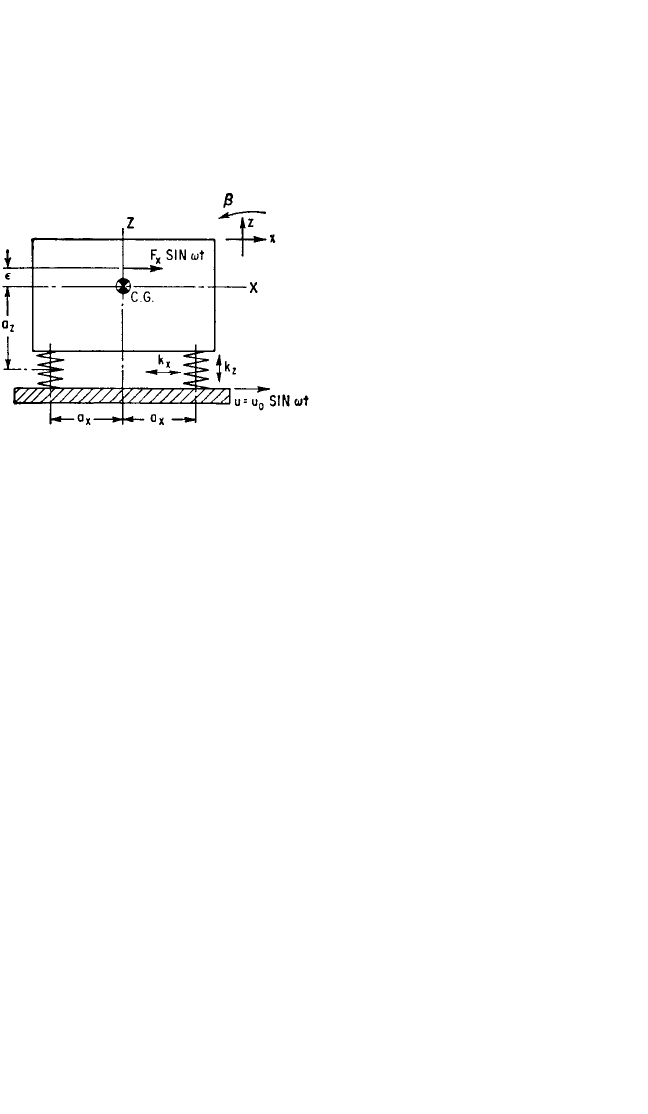
ners. It is symmetrical with respect to two coordinate vertical planes through the cen-
ter-of-gravity of the equipment, one of the planes being parallel with the plane of the
paper. Because of this symmetry, vibration in the vertical translational mode is decou-
pled from vibration in the horizontal and rotational modes. The natural frequency in
the vertical translational mode is ω
z
=
Σk
z
/m, where Σk
z
is the sum of the vertical
stiffnesses of the isolators.
Consider excitation by a periodic
force F = F
x
sin ωt applied in the direc-
tion of the X axis at a distance above
the center-of-gravity and in one of the
planes of symmetry. The differential
equations of motion for the equipment
in the coupled horizontal translational
and rotational modes are obtained by
substituting in Eq. (3.31) the conditions
of symmetry defined by Eqs. (3.33),
(3.34), (3.35), and (3.38). The resulting
equations of motion are
m¨x =−4k
x
x + 4k
x
aβ+F
x
sin ωt (30.24)
I
y
¨
β=4k
x
ax − 4k
x
a
2
β−4k
y
b
2
β−F
x
sin ωt
Making the common assumption that
transients may be neglected in systems
undergoing forced vibration, the transla-
tional and rotational displacements of
the supported body are assumed to be
harmonic at the excitation frequency.
The differential equations of motion
then are solved simultaneously to give
the following expressions for the displacement amplitudes x
0
in horizontal transla-
tion and β
0
in rotation:
x
0
=
β
0
=
(30.25)
where A
1
=
(ηa
z
2
+ a
x
2
−ηa
z
) −
2
A
2
=
2
+ (a
z
− ) (30.26)
D =
4
−
η+η +
2
+η
2
In the above equations, η=k
x
/k
z
is the dimensionless ratio of horizontal stiffness to
vertical stiffness of the isolators, ρ
y
= I
y
/m
is the radius of gyration of the supported
a
x
ρ
y
ω
ω
z
a
x
2
ρ
y
2
a
z
2
ρ
y
2
ω
ω
z
η
ρ
y
ω
ω
z
ρ
y
ω
ω
z
1
ρ
y
2
A
2
D
F
x
4ρ
y
k
z
A
1
D
F
x
4k
z
THEORY OF VIBRATION ISOLATION 30.19
FIGURE 30.17 Schematic diagram in elevation
of a rigid equipment supported upon four vibra-
tion isolators. The plane of the paper extends ver-
tically through the center-of-gravity; the system is
symmetrical with respect to this plane and with
respect to a vertical plane through the center-of-
gravity perpendicular to the paper. The moment
of inertia of the equipment with respect to an axis
through the center-of-gravity and normal to the
paper is I
y
. Excitation of the system is alterna-
tively a vibratory force F
x
sin ωt applied to the
equipment or a vibratory displacement u = u
0
sin
ωt of the foundation.
8434_Harris_30_b.qxd 09/20/2001 11:41 AM Page 30.19

body about an axis through its center-of-gravity and perpendicular to the paper,
ω
z
=
Σk
z
/m is the undamped natural frequency in vertical translation, ω is the forc-
ing frequency, a
z
is the vertical distance from the effective height of spring (mid-
height if symmetrical top to bottom)* to center-of-gravity of body m, and the other
parameters are as indicated in Fig. 30.17.
Forced vibration of the system shown in Fig. 30.17 also may be excited by peri-
odic motion of the support in the horizontal direction, as defined by u = u
0
sin ωt. The
differential equations of motion for the supported body are
m¨x = 4k
x
(u − x − a
z
β)
I
y
¨
β=−4a
z
k
x
(u − x − a
z
β) − 4k
z
a
x
2
β
(30.27)
Neglecting transients, the motion of the mounted body in horizontal translation and
in rotation is assumed to be harmonic at the forcing frequency. Equations (30.27)
may be solved simultaneously to obtain the following expressions for the displace-
ment amplitudes x
0
in horizontal translation and β
0
in rotation:
x
0
=β
0
= (30.28)
where the parameters B
1
and B
2
are
B
1
=η
−
B
2
=
2
(30.29)
and D is given by Eq. (30.26).
Natural Frequencies—Two Planes of Symmetry. In forced vibration, the
amplitude becomes a maximum when the forcing frequency is approximately equal
to a natural frequency. In an undamped system, the amplitude becomes infinite at
resonance. Thus, the natural frequency or frequencies of an undamped system may
be determined by writing the expression for the displacement amplitude of the sys-
tem in forced vibration and finding the excitation frequency at which this amplitude
becomes infinite. The denominators of Eqs. (30.25) and (30.28) include the parame-
ter D defined by Eq. (30.26). The natural frequencies of the system in coupled rota-
tional and horizontal translational modes may be determined by equating D to zero
and solving for the forcing frequencies:
4
×=
η
2
1 +
+ 1 ±
η
2
1
+
+
1
2
−
4
η
2
(30.30)
where ω
xβ
designates a natural frequency in a coupled rotational (β) and horizontal
translational (x) mode, and ω
z
designates the natural frequency in the decoupled
ρ
y
a
x
a
z
2
ρ
y
2
ρ
y
a
x
a
z
2
ρ
y
2
ρ
y
a
x
1
2
ρ
y
a
x
ω
xβ
ω
z
ω
ω
z
ηa
z
ρ
y
ω
2
ω
z
2
a
x
2
ρ
y
2
u
0
B
2
ρ
y
D
u
0
B
1
D
30.20 CHAPTER THIRTY
* The distance a
z
is taken to the mid-height of the spring to include in the equations of motion the moment
applied to the body m by the fixed-end spring. If the spring is hinged to body m, the appropriate value for a
z
is the distance from the X axis to the hinge axis.
8434_Harris_30_b.qxd 09/20/2001 11:41 AM Page 30.20
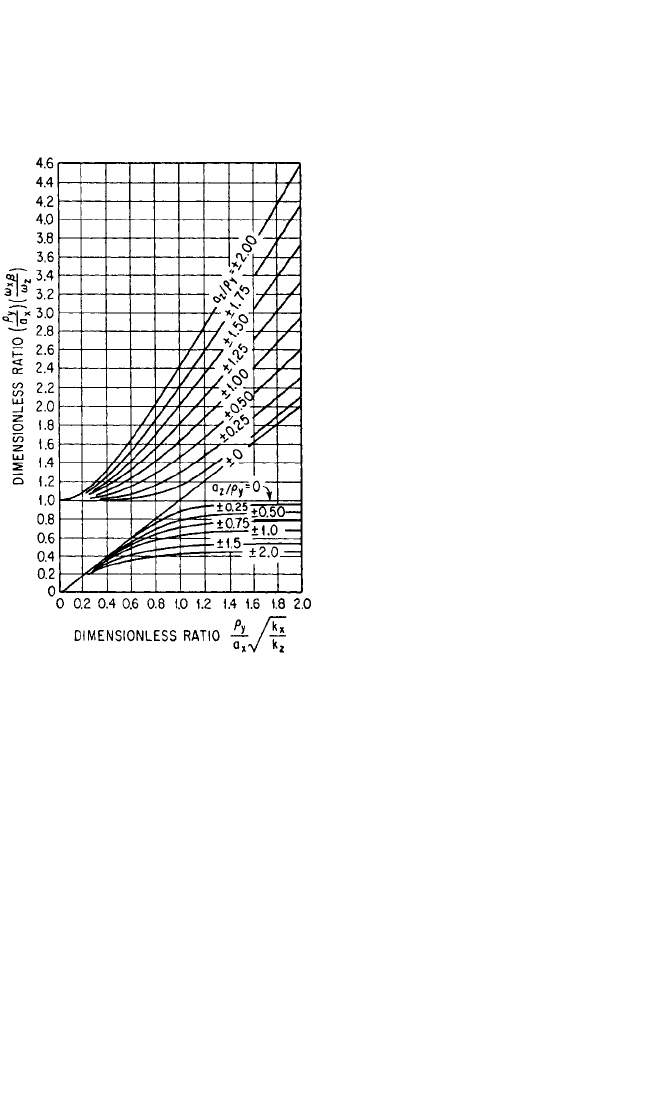
vertical translational mode. The other parameters are defined in connection with
Eq. (30.26). Two numerically different values of the dimensionless frequency ratio
ω
xβ
/ω
z
are obtained from Eq. (30.30), corresponding to the two discrete coupled
modes of vibration. Curves computed from Eq. (30.30) are given in Fig. 30.18.
The ratio of a natural frequency in a
coupled mode to the natural frequency
in the vertical translational mode is a
function of three dimensionless ratios,
two of the ratios relating the radius of
gyration ρ
y
to the dimensions a
z
and a
x
while the third is the ratio η of horizontal
to vertical stiffnesses of the isolators. In
applying the curves of Fig. 30.18, the
applicable value of the abscissa ratio is
first determined directly from the con-
stants of the system. Two appropriate
numerical values then are taken from
the ordinate scale, as determined by the
two curves for applicable values of a
z
/ρ
y
;
the ratios of natural frequencies in cou-
pled and vertical translational modes are
determined by dividing these values by
the dimensionless ratio ρ
y
/a
x
.The natural
frequencies in coupled modes then are
determined by multiplying the resulting
ratios by the natural frequency in the
decoupled vertical translational mode.
The two straight lines in Fig. 30.18 for
a
z
/ρ
y
= 0 represent natural frequencies in
decoupled modes of vibration. When
a
z
= 0, the elastic supports lie in a plane
passing through the center-of-gravity of
the equipment. The horizontal line at a
value of unity on the ordinate scale rep-
resents the natural frequency in a rota-
tional mode. The inclined straight line
for the value a
z
/ρ
y
= 0 represents the nat-
ural frequency of the system in horizon-
tal translation.
Calculation of the coupled natural
frequencies of a rigid body on resilient
supports from Eq. (30.30) is sufficiently laborious to encourage the use of graphical
means. For general purposes, both coupled natural frequencies can be obtained from
Fig. 30.18. For a given type of isolators, η=k
x
/k
z
is a constant and Eq. (30.30) may be
evaluated in a manner that makes it possible to select isolator positions to attain
optimum natural frequencies.
5
This is discussed under Space-Plots in Chap. 3. The
convenience of the approach is partially offset by the need for a separate plot for
each value of the stiffness ratio k
x
/k
z
. Applicable curves are plotted for several val-
ues of k
x
/k
z
in Figs. 3.17 to 3.19.
The preceding analysis of the dynamics of a rigid body on resilient supports
includes the assumption that the principal axes of inertia of the rigid body are,
respectively, parallel with the principal elastic axes of the resilient supports. This
makes it possible to neglect the products of inertia of the rigid body. The coupling
THEORY OF VIBRATION ISOLATION 30.21
FIGURE 30.18 Curves of natural frequencies
ω
x
β in coupled modes with reference to the nat-
ural frequency in the decoupled vertical trans-
lational mode ω
z
, for the system shown
schematically in Fig. 30.17. The isolator stiff-
nesses in the X and Z directions are indicated by
k
x
and k
z
, respectively, and the radius of gyration
with respect to the Y axis through the center-of-
gravity is indicated by ρ
y
.
8434_Harris_30_b.qxd 09/20/2001 11:41 AM Page 30.21
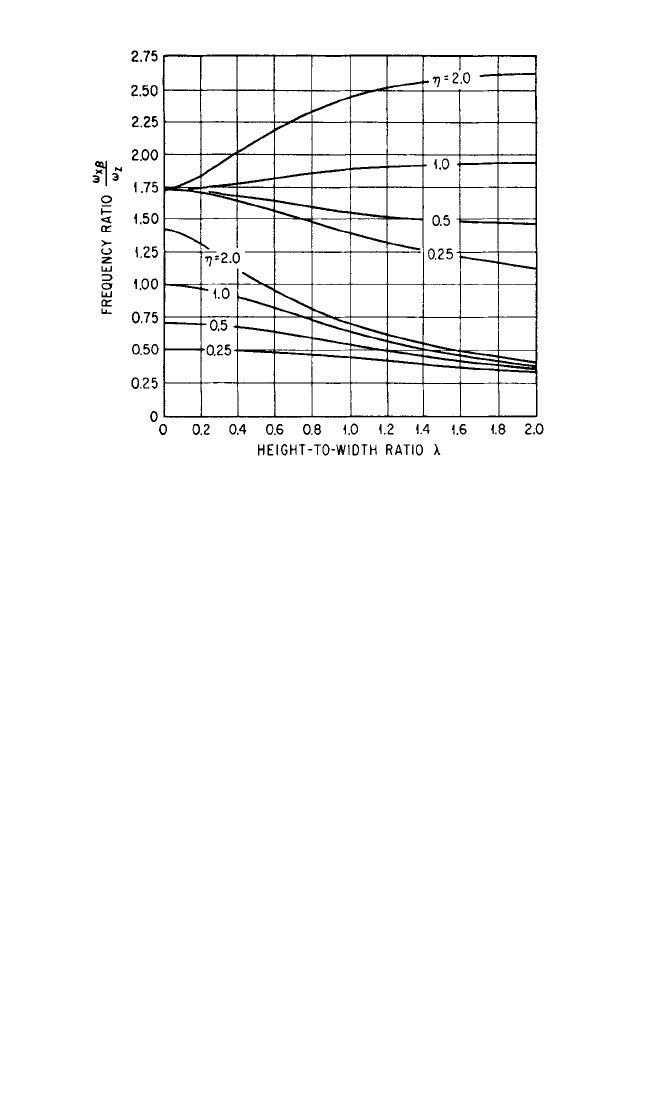
introduced by the product of inertia is not strong unless the angle between the
above-mentioned inertia and elastic axes is substantial. It is convenient to take the
coordinate axes through the center-of-gravity of the supported body, parallel with
the principal elastic axes of the isolators. If the moments of inertia with respect to
these coordinate axes are used in Eqs. (30.24) to (30.30), the calculated natural fre-
quencies usually are correct within a few percent without including the effect of
product of inertia. When it is desired to calculate the natural frequencies accurately
or when the product of inertia coupling is strong, a calculation procedure is available
that may be used for certain conventional arrangements using four isolators.
6
The procedure for determining the natural frequencies in coupled modes sum-
marized by the curves of Fig. 30.18 represents a rigorous analysis where the assumed
symmetry exists. The procedure is somewhat indirect because the dimensionless
ratio ρ
y
/a
x
appears in both ordinate and abscissa parameters and because it is neces-
sary to determine the radius of gyration of the equipment. The relations may be
approximated in a more readily usable form if (1) the mounted equipment can be
considered a cuboid having uniform mass distribution, (2) the four isolators are
attached precisely at the four lower corners of the cuboid, and (3) the height of the
isolators may be considered negligible. The ratio of the natural frequencies in the
coupled rotational and horizontal translational modes to the natural frequency in
the vertical translational mode then becomes a function of only the dimensions of
the cuboid and the stiffnesses of the isolators in the several coordinate directions.
Making these assumptions and substituting in Eq. (30.30),
30.22 CHAPTER THIRTY
FIGURE 30.19 Curves indicating the natural frequencies ω
x
β in cou-
pled rotational and horizontal translational modes with reference to
the natural frequency ω
z
in the decoupled vertical translational mode,
for the system shown in Fig. 30.17. The ratio of horizontal to vertical
stiffness of the isolators is η, and the height-to-width ratio for the
equipment is λ. These curves are based upon the assumption that the
mass of the equipment is uniformly distributed and that the isolators
are attached precisely at the extreme lower corners thereof.
8434_Harris_30_b.qxd 09/20/2001 11:41 AM Page 30.22

=
±
2
−
(30.31)
where η=k
x
/k
z
designates the ratio of horizontal to vertical stiffness of the isola-
tors and λ=2a
z
/2a
x
indicates the ratio of height to width of mounted equipment.
This relation is shown graphically in Fig. 30.19. The curves included in this figure
are useful for calculating approximate values of natural frequencies and for indi-
cating trends in natural frequencies resulting from changes in various parameters
as follows:
1. Both of the coupled natural frequencies tend to become a minimum, for any
ratio of height to width of the mounted equipment, when the ratio of horizontal to
vertical stiffness k
x
/k
z
of the isolators is low. Conversely, when the ratio of horizon-
tal to vertical stiffness is high, both coupled natural frequencies also tend to be
high. Thus, when the isolators are located underneath the mounted body, a condi-
tion of low natural frequencies is obtained using isolators whose stiffness in a hori-
zontal direction is less than the stiffness in a vertical direction. However, low
horizontal stiffness may be undesirable in applications requiring maximum stabil-
ity. A compromise between natural frequency and stability then may lead to opti-
mum conditions.
2. As the ratio of height to width of the mounted equipment increases, the lower
of the coupled natural frequencies decreases. The trend of the higher of the coupled
natural frequencies depends on the stiffness ratio of the isolators. One of the cou-
pled natural frequencies tends to become very high when the horizontal stiffness of
the isolators is greater than the vertical stiffness and when the height of the mounted
equipment is approximately equal to or greater than the width. When the ratio of
height to width of mounted equipment is greater than 0.5, the spread between the
coupled natural frequencies increases as the ratio k
x
/k
z
of horizontal to vertical stiff-
ness of the isolators increases.
Natural Frequency—Uncoupled Rotational Mode. Figure 30.20 is a plan view
of the body shown in elevation in Fig. 30.17. The distances from the isolators to the
principal planes of inertia are designated by a
x
and a
y
. The horizontal stiffnesses of
the isolators in the directions of the coordinate axes X and Y are indicated by k
x
and
k
y
, respectively. When the excitation is
the applied couple M = M
0
sin ωt, the
differential equation of motion is
I
z
¨
γ=−4γa
x
2
k
y
− 4γa
y
2
k
x
+ M
0
sin ωt
(30.32)
where I
z
is the moment of inertia of the
body with respect to the Z axis. Neglect-
ing transient terms, the solution of Eq.
(30.32) gives the displacement ampli-
tude γ
0
in rotation:
γ
0
= (30.33)
M
0
4(a
x
2
k
y
+ a
y
2
k
x
) − I
z
ω
2
12η
λ
2
+ 1
4ηλ
2
+η+3
λ
2
+ 1
4ηλ
2
+η+3
λ
2
+ 1
1
2
ω
xβ
ω
z
THEORY OF VIBRATION ISOLATION 30.23
FIGURE 30.20 Plan view of the equipment
shown schematically in Fig. 30.17, indicating the
uncoupled rotational mode specified by the
rotation angle γ.
8434_Harris_30_b.qxd 09/20/2001 11:41 AM Page 30.23
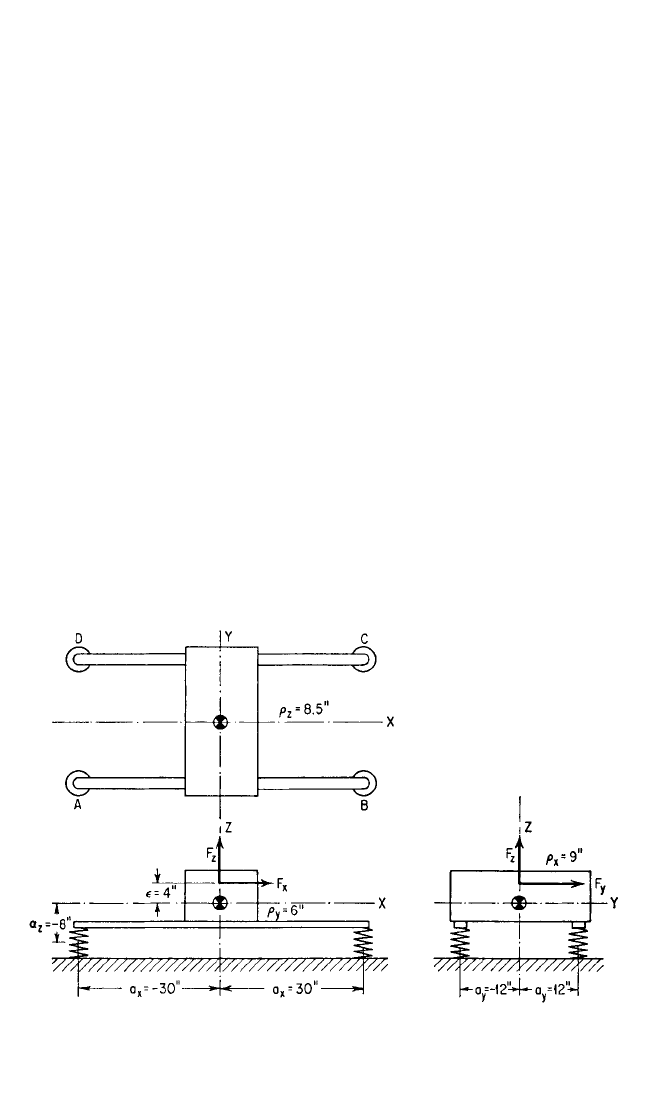
where the natural frequency ω
γ
in rotation about the Z axis is the value of ω that
makes the denominator of Eq. (30.33) equal to zero:
ω
γ
= 2
(30.34)
VIBRATION ISOLATION IN COUPLED MODES
When the equipment and isolator system has several degrees-of-freedom and the
isolators are located in such a manner that several natural modes of vibration are
coupled, it becomes necessary in evaluating the isolators to consider the contribu-
tion of the several modes in determining the motion transmitted from the support to
the mounted equipment or the force transmitted from the equipment to the founda-
tion. Methods for determining the transmissibility under these conditions are best
illustrated by examples.
For example, consider the system shown schematically in Fig. 30.21 wherein a
machine is supported by relatively long beams which are in turn supported at their
opposite ends by vibration isolators. The isolators are assumed to be undamped,
and the excitation is considered to be a force applied at a distance = 4 in. above
the center-of-gravity of the machine-and-beam assembly. Alternatively, the force is
(1) F
x
= F
0
cos ωt, F
z
= F
0
sin ωt in a plane normal to the Y axis or (2) F
y
= F
0
cos ωt,
F
z
= F
0
sin ωt in a plane normal to the X axis. This may represent an unbalanced
weight rotating in a vertical plane. A force transmissibility at each of the four isola-
tors is determined by calculating the deflection of each isolator, multiplying the
a
x
2
k
y
+ a
y
2
k
x
I
z
30.24 CHAPTER THIRTY
FIGURE 30.21 Schematic diagram of an equipment mounted upon relatively long beams
which are in turn attached at their opposite ends to vibration isolators. Excitation for the sys-
tem is alternatively (1) the vibratory force F
x
= F
0
cos ωt, F
Z
= F
0
sin ωt in the XZ plane or (2)
the vibratory force F
y
= F
0
cos ωt, F
Z
= F
0
sin ωt in the YZ plane.
8434_Harris_30_b.qxd 09/20/2001 11:41 AM Page 30.24
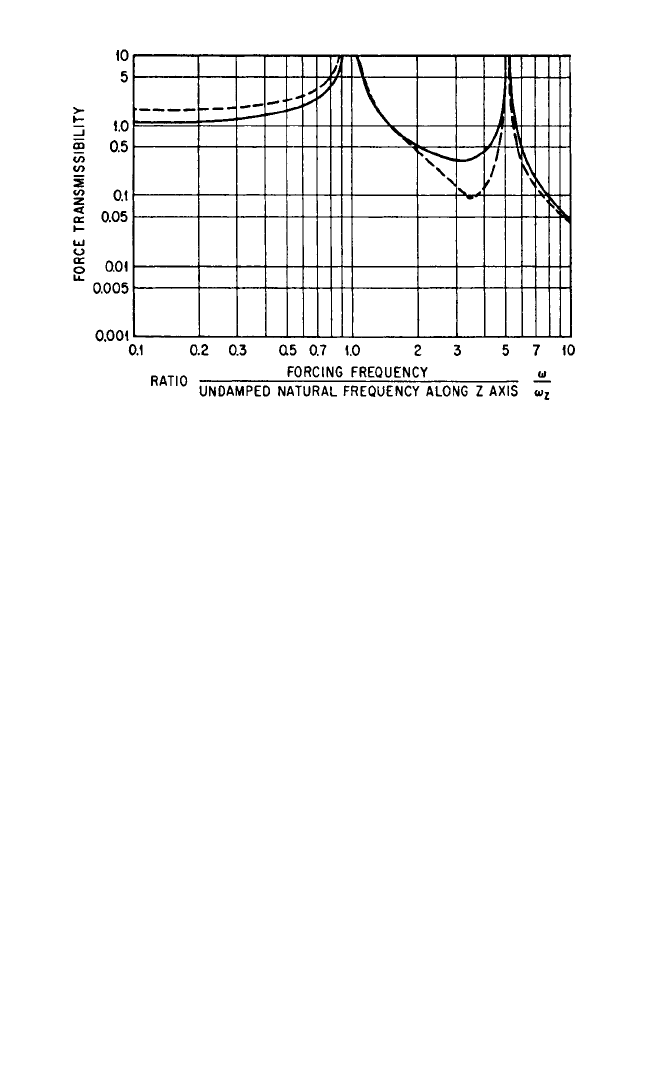
deflection by the appropriate isolator stiffness to obtain transmitted force, and
dividing it by F
0
/4.
When the system is viewed in a vertical plane perpendicular to the Y axis, the
transmissibility curves are as illustrated in Fig. 30.22.The solid line defines the trans-
missibility at each of isolators B and C in Fig. 30.21, and the dotted line defines the
transmissibility at each of isolators A and D. Similar transmissibility curves for a
plane perpendicular to the X axis are shown in Fig. 30.23 wherein the solid line indi-
cates the transmissibility at each of isolators C and D, and the dotted line indicates
the transmissibility at each of isolators A and B.
Note the comparison of the transmissibility curves of Figs. 30.22 and 30.23 with
the diagram of the system in Fig. 30.21. Figure 30.23 shows the three resonance con-
ditions which are characteristic of a coupled system of the type illustrated.The trans-
missibility remains equal to or greater than unity for all excitation frequencies lower
than the highest resonance frequency in a coupled mode. At greater excitation fre-
quencies, vibration isolation is attained, as indicated by values of force transmissibil-
ity smaller than unity.
The transmissibility curves in Fig. 30.22 show somewhat similar results. The long
horizontal beams tend to spread the resonance frequencies by a substantial fre-
quency increment and merge the resonance frequency in the vertical translational
mode with the resonance frequency in one of the coupled modes. A low transmissi-
bility is again attained at excitation frequencies greater than the highest resonance
frequency. Note that the transmissibility drops to a value slightly less than unity over
a small frequency interval between the predominant resonance frequencies. This is a
force reduction resulting from the relatively long beams, and it constitutes an
acceptable condition if the magnitude of the excitation force in this direction is rel-
atively small. Thus, the natural frequencies of the isolators could be somewhat
higher with a consequent gain in stability; it is necessary, however, that the excitation
frequency be substantially constant.
THEORY OF VIBRATION ISOLATION 30.25
FIGURE 30.22 Transmissibility curves for the system shown in Fig. 30.21
when the excitation is in a plane perpendicular to the Y axis. The solid line indi-
cates the transmissibility at each of isolators B and C, whereas the dotted line
indicates the transmissibility at each of isolators A and D.
8434_Harris_30_b.qxd 09/20/2001 11:41 AM Page 30.25
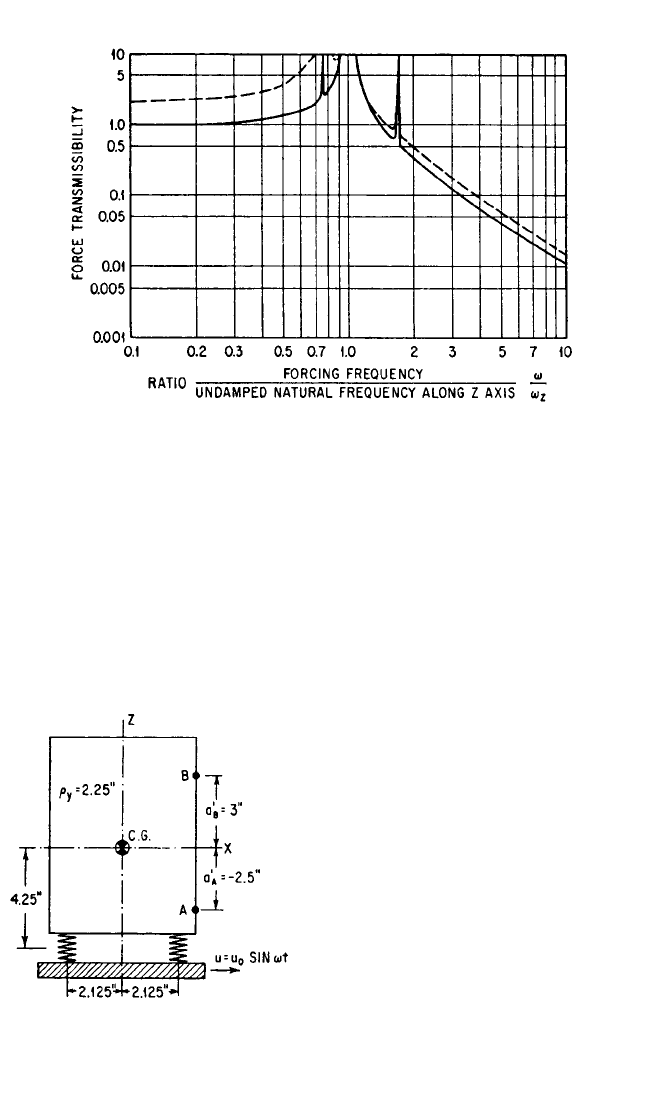
Consider the equipment illustrated in Fig. 30.24 when the excitation is horizontal
vibration of the support. The effectiveness of the isolators in reducing the excitation
vibration is evaluated by plotting the displacement amplitude of the horizontal
vibration at points A and B with reference to the displacement amplitude of the sup-
port. Transmissibility curves for the system of Fig. 30.24 are shown in Fig. 30.25. The
solid line in Fig. 30.25 refers to point A and the dotted line to point B. Note that
there is no significant reduction of amplitude except when the forcing frequency
exceeds the maximum resonance frequency of the system.
A general rule for the calculation of
necessary isolator characteristics to
achieve the results illustrated in Figs.
30.22, 30.23, and 30.25 is that the forcing
frequency should be not less than 1.5 to 2
times the maximum natural frequency in
any of six natural modes of vibration.
In exceptional cases, such as illustrated in
Fig. 30.22, the forcing frequency may be
interposed between resonance frequen-
cies if the forcing frequency is a constant.
Example 30.1. Consider the ma-
chine illustrated in Fig. 30.21. The force
that is to be isolated is harmonic at the
constant frequency of 8 Hz; it is assumed
to result from the rotation of an unbal-
anced member whose plane of rotation
is alternatively (1) a plane perpendicu-
lar to the Y axis and (2) a plane per-
pendicular to the X axis. The distance
30.26 CHAPTER THIRTY
FIGURE 30.23 Transmissibility curves for the system illustrated in Fig. 30.21
when the excitation is in a plane perpendicular to the X axis. The solid line indi-
cates the transmissibility at each of isolators C and D, whereas the dotted line
indicates the transmissibility at each of isolators A and B.
FIGURE 30.24 Schematic diagram of an
equipment supported by vibration isolators.
Excitation is a vibratory displacement u = u
0
sin
ωt of the foundation.
8434_Harris_30_b.qxd 09/20/2001 11:41 AM Page 30.26
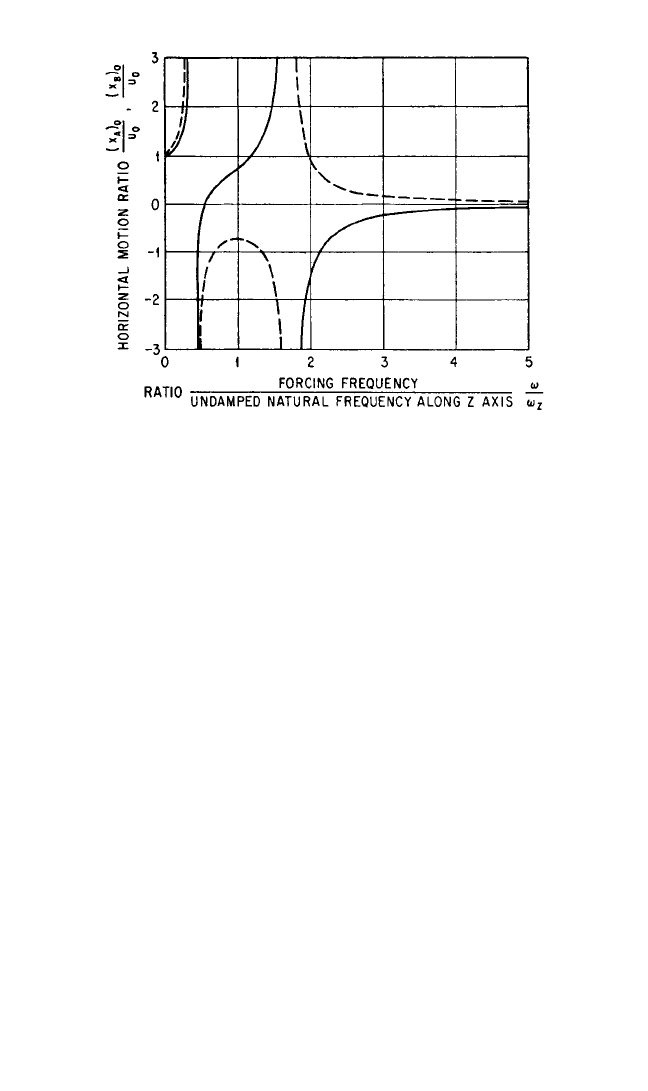
between isolators is 60 in. in the direction of the X axis and 24 in. in the direction of
the Y axis. The center of coordinates is taken at the center-of-gravity of the sup-
ported body, i.e., at the center-of-gravity of the machine-and-beams assembly. The
total weight of the machine and supporting beam assembly is 100 lb, and its radii of
gyration with respect to the three coordinate axes through the center-of-gravity are
ρ
x
= 9 in., ρ
z
= 8.5 in., and ρ
y
= 6 in. The isolators are of equal stiffnesses in the direc-
tions of the three coordinate axes:
η===1
The following dimensionless ratios are established as the initial step in the solution:
a
z
/ρ
y
=−1.333 a
z
/ρ
x
=−0.889
a
x
/ρ
y
=±5.0 a
y
/ρ
x
=±1.333
(a
z
/ρ
y
)
2
= 1.78 (a
z
/ρ
x
)
2
= 0.790
(a
x
/ρ
y
)
2
= 25.0 (a
y
/ρ
x
)
2
= 1.78
η(ρ
y
/a
x
)
2
= 0.04 η(ρ
x
/a
y
)
2
= 0.561
The various natural frequencies are determined in terms of the vertical natural fre-
quency ω
z
. Referring to Fig. 30.18, the coupled natural frequencies for vibration in a
plane perpendicular to the Y axis are determined as follows:
k
y
k
z
k
x
k
z
THEORY OF VIBRATION ISOLATION 30.27
FIGURE 30.25 Displacement transmissibility curves for the system
of Fig. 30.24. Transmissibility between the foundation and point A is
shown by the solid line; transmissibility between the foundation and
point B is shown by the dotted line.
8434_Harris_30_b.qxd 09/20/2001 11:41 AM Page 30.27

First calculate the parameter
= 0.2
For a
z
/ρ
y
=−1.333, (ω
xβ
/ω
z
)(ρ
y
/a
x
) = 0.19; 1.03. Note the signs of the dimensionless
ratios a
z
/ρ
y
and a
x
/ρ
y
. According to Eq. (30.30), the natural frequencies are inde-
pendent of the sign of a
z
/ρ
y
. With regard to the ratio a
x
/ρ
y
, the sign chosen should be
the same as the sign of the radical on the right side of Eq. (30.30). The frequency
ratio (ω
xβ
/ω
z
) then becomes positive. Dividing the above values for (ω
xβ
/ω
z
)(ρ
y
/a
x
) by
ρ
y
/a
x
= 0.2, ω
xβ
/ω
z
= 0.96; 5.15.
Vibration in a plane perpendicular to the X axis is treated in a similar manner. It
is assumed that exciting forces are not applied concurrently in planes perpendicular
to the X and Y axes; thus, vibration in these two planes is independent. Conse-
quently, the example entails two independent but similar problems and similar equa-
tions apply for a plane perpendicular to the X axis:
= 0.75
For a
z
/ρ
x
= 0.889, (ω
yα
/ω
z
)(ρ
x
/a
y
) = 0.57; 1.29. Dividing by ρ
x
/a
y
= 0.75, ω
yα
/ω
z
= 0.76; 1.72.
The natural frequency in rotation with respect to the Z axis is calculated from Eq.
(30.34) as follows, taking into consideration that there are two pairs of springs and
that k
x
= k
y
= k
z
:
ω
γ
=
= 3.8ω
z
The six natural frequencies are as follows:
1. Translational along Z axis: ω
z
2. Coupled in plane perpendicular to Y axis: 0.96ω
z
3. Coupled in plane perpendicular to Y axis: 5.15ω
z
4. Coupled in plane perpendicular to X axis: 0.76ω
z
5. Coupled in plane perpendicular to X axis: 1.72ω
z
6. Rotational with respect to Y axis: 3.8ω
z
Considering vibration in a plane perpendicular to the Y axis, the two highest nat-
ural frequencies are the natural frequency ω
y
in the translational mode along the Z
axis and the natural frequency 5.15ω
z
in a coupled mode. In a similar manner, the
two highest natural frequencies in a plane perpendicular to the X axis are the natu-
ral frequency ω
z
in translation along the Z axis and the natural frequency 1.72ω
z
in a
coupled mode. The natural frequency in rotation about the Z axis is 3.80ω
z
.The
widest frequency increment which is void of natural frequencies is between 1.72ω
z
and 3.80ω
z
. This increment is used for the forcing frequency which is taken as 2.5ω
z
.
Inasmuch as the forcing frequency is established at 8 Hz, the vertical natural fre-
quency is 8 divided by 2.5, or 3.2 Hz. The required vertical stiffnesses of the isolators
are calculated from Eq. (30.11) to be 105 lb/in. for the entire machine, or 26.2 lb/in.
for each of the four isolators.
4k
z
g
W
a
x
2
+ a
y
2
ρ
z
2
k
z
k
y
ρ
x
a
y
k
x
k
z
ρ
y
a
x
30.28 CHAPTER THIRTY
8434_Harris_30_b.qxd 09/20/2001 11:41 AM Page 30.28
